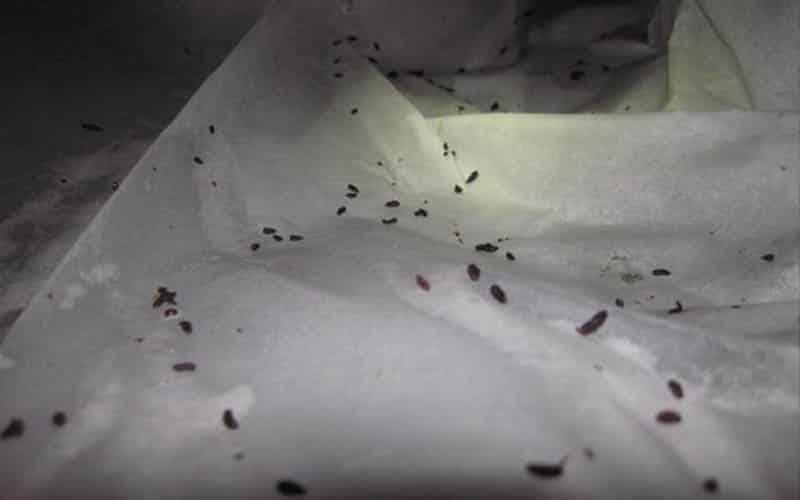Analytical Chemistry Analysis of Bat Guano:
An Investigation into Species-Specific Bat Detection via Olfaction
Mary E. Cablk, Ph.D., John C. Sagebiel, Ph.D.* and Mark McDaniel, Ph.D.
*University of Nevada, Reno
This project was funded by the US Fish and Wildlife Service through the Kentucky Natural Lands Trust and the Cooperative Ecosystem Studies Unit. Mike Armstrong and Carrie Allison played a pivotal role in data collection and project design.

Guano collected using a newly developed, non-invasive method to guide and focus analytical chemistry analysis.
Photo credit: USFWS Kentucky Field Office Bat Biologists.
Evidence from other canine disciplines (human remains detection aka “cadaver dogs”) show that a dog trained to find human remains can differentiate and will not indicate on animal remains with proper training, and that they are able to locate any individual within the ‘human’ target class (e.g., male or female, varying age, varying diet, etc.). This has some scientific support from analytical chemistry, specifically solid phase microextraction (SPME) gas chromatography/mass spectrometry (GC-MS) as well (Cablk et al., 2012). These same laboratory analyses have highlighted overlap in VOC signature categorized as generic ‘decomposition’ (Rosier et al., 2015). Relevant to guano, we used GC/MS to identify the potential odor molecules present in bat guano sampled from both sexes of multiple species, and in what relative abundances. While this method should not be considered to deliver an absolute formula for what constitutes a signature recognized by a dog, it does provide an assessment of the variability within and among guano from a single species and also across different species. This is an efficient means to gain an objective evaluation of the VOCs of a target species to guide training and testing expectations.
There were several positive outcomes from this research. First, the method of analysis was demonstrated to be effective, and this included learning the best approach to safely capture and handle the bats as they emerged or returned to their roosts. Careful consideration must be taken with samples to be analyzed in a GC-MS to reduce the likelihood of contamination. We were also able to demonstrate that the guano VOCs of interest were stable enough to persist through collection, shipping, receiving, and analysis, a process that generally took 24-48 hours to complete.
The significance of these method developments relate directly to training of bat guano detection dogs. Detection dogs of any discipline require pure source training aids to learn and maintain specificity to their target odor. Direct collection of guano using the methods described here showed machine detectable VOCs produced by guano stored in the glass vials, which provides support for producing viable training aids by bat species. If a machine can detect the VOCs from the samples, a dog can. What we cannot comment on with respect to training aids, however, is the length of time that the guano would be viable as a training aid. Our samples were frozen once they were analyzed so future analysis is an option to assess the temporal component to training aids.
There are differences in guano VOCs such that it may be expected that a canine could differentiate between species. However, there exists variability within species to suggest that training aids (guano) would need to be considered carefully. The primary consideration would be to provide the canine with guano collected from the geographic location where surveys would occur. For canines deployed to cover a wide range of geography, a similarly diverse constituent guanos would be advised.
There was variability in the components from guano of males and females, and our analysis suggests differentiation based on VOCs may be possible, if species specificity is ignored. We did not have sufficient sample size to assess both species specificity and sex in terms of VOC based separability. There were differences in the compound categories that were reported from samples by sex, although the source of those differences are difficult to identify with certainty from our analysis. The obvious possibility, diet, is worth further investigation because presumably males and females are eating similar diets, although perhaps there are some differences that have yet to be explored. If there is no dietary difference, then it should be a biological difference tied to sex. Therefore while we might hypothesize that there may be an olfactory difference between the sexes, there would likely be other factors related to sex (e.g., hormones) that could affect odor too. These compounds are not measured in the GC-MS instrumentation so we cannot contribute much to a discussion surrounding them.
Clearly there exist VOCs that would comprise an odor signature that a canine could detect, since our instruments were able to detect them. With that said, it is important to remember that the results of analytical chemistry cannot be assumed to be the equivalent mixture of what a dog uses to recognize ‘target odor’. For complex targets such as guano, it remains unknown what a dog’s recognized odor signature would be. Because we were able to capture and report VOCs that made logical sense from a biological and chemical perspective, it seems quite reasonable to expect a dog could not only be trained to recognize bat guano as a target odor, but possibly differentiate species.
contact
Mary Cablk, Ph.D.
Earth and Ecosystem Sciences
2215 Raggio Parkway
Reno NV 89512
775-673-7371
Mary.Cablk@dri.edu